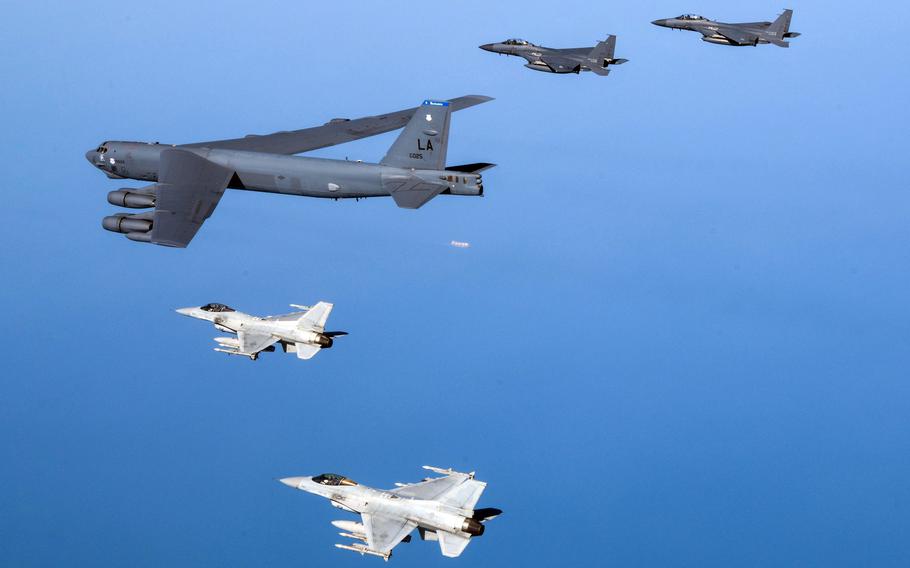
A U.S. Air Force B-52H Stratofortress bomber flies alongside South Korean F-15K Slam Eagles and KF-16s over the Yellow Sea, March 6, 2023. (South Korean Ministry of National Defense)
“The training offered the alliance an opportunity to further strengthen its interoperability by demonstrating a combined defense capability, rapid deployment, and extended deterrence in the defense of the Korean Peninsula.”
This U.S. Air Force news release, issued June 30, describes drills in South Korea involving intercontinental B-52 bombers along with tactical fighter aircraft. The media message describes significant escalation in the ongoing confrontation between North Korea and South Korea.
The B-52 Stratofortresses that traveled from the United States date from the 1950s and the height of the Cold War. They have undergone retrofitting over the years but remain essentially as designed and constructed more than a half century ago.
The B-52 is not only an example of the exceptional military design and development capabilities of this country, but also a symbolic reminder of the continuity of some conflicts in the world as well as the horrific possibility of nuclear war.
This bomber has proven to be flexible as well as durable, in ways unforeseen during the original creation. The construction in the 1950s was a function primarily of the need to deter the Soviet Union by the potential delivery of nuclear weapons on targets there and elsewhere. By the following decade, B-52s were actually delivering conventional bombs on targets in both North and South Vietnam during our long war there.
The B-52s in the current exercise flew from Barksdale Air Force Base in Louisiana. They are separate from others, deployed to South Korea since mid-June, that are from Minot Air Force Base in North Dakota.
Additionally, the Biden administration plans to send the largest nuclear-armed U.S. submarine to South Korea for the first time in four decades. The powerful Ohio-class submarine is capable of staying submerged indefinitely and remain on patrol for months.
Remarkable long-range capabilities represent starkly the capacities of technology to bridge and minimize the challenges of geography, including the exceptional distances across the Pacific Ocean.
South Korea has also been recently visited by the USS Michigan, a submarine armed with cruise missiles, capable of great flexibility and deception in flight. This ship is actively involved in combined South Korea-U.S. special operations training.
Military partnership between our two nations is exceptionally close, dating from the devastating Korean War of 1950 to 1953. President Harry Truman deserves great credit for courageously, decisively deciding to support the United Nations effort to defend South Korea from invasion by the North. Newly-inaugurated President Dwight D. Eisenhower was finally able to secure an armistice ending the war in 1953.
During our long Vietnam War, South Korea maintained approximately 50,000 troops in South Vietnam. In contrast to U.S. military force profiles, almost all these soldiers and marines were combat troops. Their approach to combat sparked some controversies, but there was no doubt that they were extremely effective. North Vietnam Army and Viet Cong revolutionary forces actively tried to avoid contact with the Koreans.
North Korea is engaged in ominous long-range missile tests, with evidence of steady improvement in launch and delivery capabilities. U.S. efforts to restrict this dangerous behavior by working through the United Nations have been consistently stymied by China and Russia.
Expanding cooperation between Seoul and Washington builds directly on South Korea President Yoon Suk Yeol’s successful six-day visit to Washington in April, marking the 70th anniversary of the vital alliance between our two nations.
As emphasized in an earlier column, Yoon has opportunities to develop a starring global leadership role, with noisy North Korea shunted off to stage left. At a White House state dinner, he sang Don McLean’s 1971 song “American Pie.”
Arthur I. Cyr is the author of “After the Cold War — American Foreign Policy, Europe and Asia.”